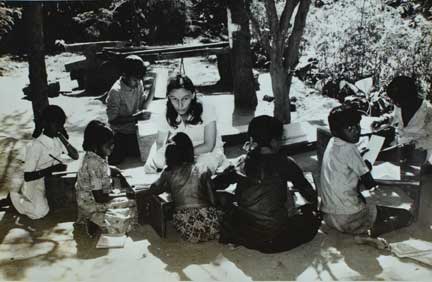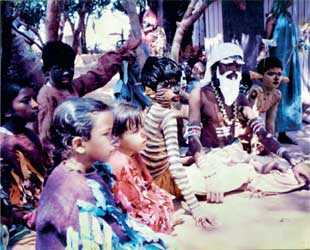Jane Sahi
Beginning a new venture can bring a very special energy. It was in 1975 that the play group that was happening in our home began to turn into a school. It happened in a very organic way as the play group began more and more to include older siblings who had never gone to school or rapidly dropped out if they had ever started. I look back with joy remembering those older children’s enthusiasm and how a number of them would come early in the morning and only leave as it became dark. The school grew from those very small beginnings, but on average over the years, the school had about 45 children between the ages of 4 and 14.
At that time, although the village was just 25 km from Bengaluru there was no tarred road and no bus, no TV and no telephone. Very few people worked outside the immediate locality and the tiny handful of people who had passed their 10th standard public exam had done so from a distant residential school. Families at that time were large – an average of six children – and the children supported their families by caring for younger siblings or working on the land or as casual labour on local construction sites. Some children as young as 10 or 11 were employed in domestic service away from home. Aspirations were low and parents had little expectation that the local school would enable children to find more lucrative employment.

Undeniably, there was a kind of naiveté in the discussions about what schooling could mean in this context but there was also an optimism that some meaningful response could emerge. In those early days it was clear – without being romantic – that there were a number of very positive elements in the children’s way of life. The children were expected to be responsible members of a community and did actively contribute to the well-being of their families. In addition, the children had a certain knowledge of where their basic resources came from whether food or the construction materials for houses and they participated in the rhythm of the year with its seasons and the agricultural cycle. The growing awareness of the risks and exploitation of child labour are very pertinent but nevertheless the children did enjoy a certain freedom to move about and were not under pressure to be in certain places at certain times with particular people, in the way that most children’s lives are monitored now – be it in tuition classes or confined to the school classroom in the company of children of the same age.
It was some of these positive aspects that the school tried to integrate, so for example, groupings were often vertical and collaboration was emphasized rather than focusing largely on individual achievement. There was an effort to evolve a curriculum that was based on the children’s life experience and context and to encourage children to work creatively with their hands and to feel responsible for the maintenance of the school environment. Ten years later when we did build a school, the structures were designed to create a fluid space between inside and outside so that children did not feel confined within the walls of a classroom.
The school was called ‘Sita School’ because one of the meanings of ‘sita’ is the furrow, which is of course, where King Janak found the baby daughter of Bhumi, the earth goddess, while ploughing. A school is like the furrow where seeds can be nurtured but a seed has its own resilience and potential to grow. Perhaps what was not recognized sufficiently was the vital relationships between the individual child, the school and the wider community. There was a tendency to see the school functioning in a vacuum and not to acknowledge the web of societal and economic forces that underlie any school.

As the school took shape there were a number of influences that affected the direction it took: the children themselves were very clear that they wanted to become competent in basic literacy and computational skills; parents increasingly voiced their concerns that children should have some form of certification to enable them to move on to other schools. A significant development was the arrival of a particularly insightful Waldorf* teacher, who over the two years that she stayed, gave a certain framework to the way we were working and affirmed a way of learning and teaching where the arts became not an extra-curricular subject but an integral part of all learning across subjects. In that way a topic such as ‘Food’ or ‘Water’ could be approached in a holistic way to include language and math, environmental studies and science.
After some years there were more demands from parents as aspirations changed in the face of urbanization and exposure to the media. From the beginning the school had been a Kannada medium school with English and Hindi very much seen as secondary languages. Already by the 80s English was understood as a language of power and the means of achieving economic and social mobility. Therefore, in all justice, English should not be reserved for an already privileged class. At that time we resisted the idea of changing to an English medium school but in retrospect I think we would have done well to heed parents’ felt needs and could have, at least, explored more seriously the possibilities of a bilingual school whereby the children’s mother tongue was foundational but English became a language that children could feel comfortable and confident to use for multiple purposes.
As the years passed we were very fortunate to have many visitors to the school who stayed for long or short periods and contributed in all sorts of ways from teaching woodwork to drama, from star gazing to screen printing. In the last few years before the school closed we had a regular volunteer who introduced the children to computers with all kinds of creative activities but also trained us all to participate in running (or walking as the case may be) if not marathons, longer distances. However, there was a vital core group of teachers who stayed and worked together for many years and sustained the school through many changes. There are so many good memories of celebrations, children’s responses to different challenges and teachers’ working sensitively and creatively to support children’s learning.
In any school there has to be an alignment of purpose between the school and the community that is served. As the village changed to become more like a suburb than a rural community, expectations of what a school should be changed quite dramatically, and inevitably there were some differences in priorities. There was little explicit confrontation but it gradually became clearer that parents’ expectations were not being met by a school that did not fit in with the status afforded by going to a convent school or a fee paying private English medium school.

There is a dilemma that an alternative school by its very nature critiques the dominant paradigm that often serves to perpetuate unjust systems and yet it obviously does not have a monopoly on deciding how “other people’s children” should be schooled. The difficult question is who is in a position to make choices and how are those choices being framed given the socio-political, environmental and economic constraints that are at work. A school is not meant to just “fit in” with norms that preserve the status quo and leave people and systems unchanged but needs to search for innovative ways to enable enquiry and explore multiple ‘ways of knowing’ about the world – past, present and to imagine possibilities for the future.
Many children who came to the school during those years might have dropped out of a less flexible school or never even started and we tried to be as inclusive as possible. Some children succeeded in the conventional sense of the word and went on to further studies; but it is hoped that all were given opportunities to learn things and express themselves in ways that they might not have, had no alternative to the mainstream school been available.
By 2005 the Right to Education Act was on the horizon and there was a realization that the kind of freedom we had enjoyed as a school was under threat. Efforts at being recognized and accountable as an alternative school, along with other schools connected to the Alternative School Network, seemed less and less likely to be successful. A number of alternative schools did go through the formal process of getting registration and recognition, but for us at that juncture it did not seem a way forward given our size, personnel and wariness about institutionalized schooling and the growing sense of centralized control of education. It was decided that the school should move towards closure.
There was a period of transition as the school wound down, but already we were beginning to think of ways to use the resources we had both in terms of teachers and materials. In the last four years – including this pandemic period – we have started in a small way, classroom libraries in nearby Kannada medium schools and a community library. We have also, in a modest way, been going to local schools and supporting teachers in language and environmental studies. It has felt that as one door closed another opened and this has proved a positive step to engage with children within the system but not losing sight of the vision of a way of teaching and learning that was inclusive and purposeful that began now more than 50 years ago. So again we are energized by a sense of a new beginning to find creative ways to respond in the here and now.
Beginnings and endings are part of a much larger pattern of a new life, ‘mellowed fruitfulness’, decay and regeneration and cannot only be reduced to a sequential or linear development. This period of the pandemic has challenged many of us to think again what schooling means because it has so starkly exposed the inequalities that some families face in struggling to prepare their children for an uncertain future. The question continues, ‘How can we think freshly of meeting children’s short-term and long-term needs?’
* Waldorf education is based on the educational philosophy of Rudolph Steiner. It should be noted that Steiner was one significant influence but Gandhi, Tagore and others also contributed to the vision of the school.
The author has taught both adults and children over many years, In the last five years she has been part of a team that teaches a Library Educators’ Course at Bookworm in Goa. She has also been involved in a small learners’ centre that works with children in local government primary schools particularly through classroom libraries and looking at nature through observation, stories and art work. She can be reached at janehelensahi@gmail.com.
